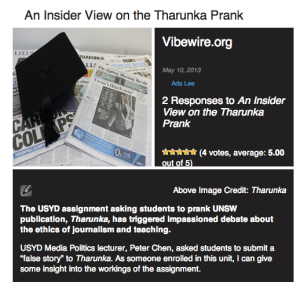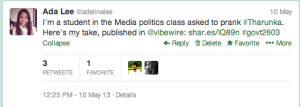Published in Honi Soit, p. 9, Wk 10 Semester 1 Edition, 15 May 2013.
The demonisation of Government lecturer Peter Chen has been largely misinformed and misleading, argues Ada Lee
Recently, some Sydney University students were given an assignment to submit a fake news article to UNSW’s student paper.
The purpose of the ‘Prank Tharunka’ assignment was to test whether the media is susceptible to manipulation. It was not attempting to raise up the next generation of lying, sensationalist journalists. GOVT2603 (Media Politics) is a politics, not a journalism, subject. Peter Chen is a media critic, not a journalist.
The majority of reactions have oversimplified the issue. At one end, we have the conniving, mohawked Dr Chen, setting out to destroy the media. The Australian suggests that “maybe the lecturer” is what’s wrong with the media. Again, this was not a journalism training exercise. At the other end, we have Tharunka, UNSW’s student publication, maliciously targeted and victimised.
Tharunka admitted to Crikey that they had planned to run a fake story on fare evasion.
Here’s a question for Tharunka: did you check the facts? Would you have noticed the prank if not for the whistleblower? The assignment’s task to post false stories only works if the media is not doing its job properly. Tharunka, if you fact-checked and sifted out all the false stories, then I salute you—for doing your job.
As journalists and editors, if all our sources were entirely truthful with no distortion, no attempts at manipulation, no deliberate omission of facts, then the media world would be a better place. Unfortunately, that’s not how it works. Journalists and editors have a responsibility to check facts, investigate and sift out spin. Yes, it takes time. Yes, it might suck. But spin happens and the media should be prepared for it.
It is not sufficient to use Peter Chen as a scapegoat. Journalists and editors are not infallible lie detectors, but they also need to take responsibility when they make mistakes.
The argument has been made that as a small university paper with few resources, Tharunka was an unsuitable case study for testing the media’s gatekeeping role. But perhaps there is a broader point. With highly concentrated media ownership and fewer journalists to fill in a demanding 24-hour news cycle, are our major news providers really better equipped?
Has the journalist watchdog been overtaken by a pack mentality where certain stories are over-emphasised and others completely missed? Is it sufficient that the media often rely on carefully planned press conferences and written statements rather than hard in-depth interviews with our political leaders?
If the big papers were bombarded with falsified stories as Tharunka was, would they pass the test? And if not, can we still trust them to bring the important issues to the surface? These are the questions we were asked to explore.
I don’t know whether encouraging students to post fake stories was the most virtuous thing to do. But what I do know is that I’ve learnt an invaluable amount about the politics of media.
For more of my coverage on the Tharunka prank, click here.





